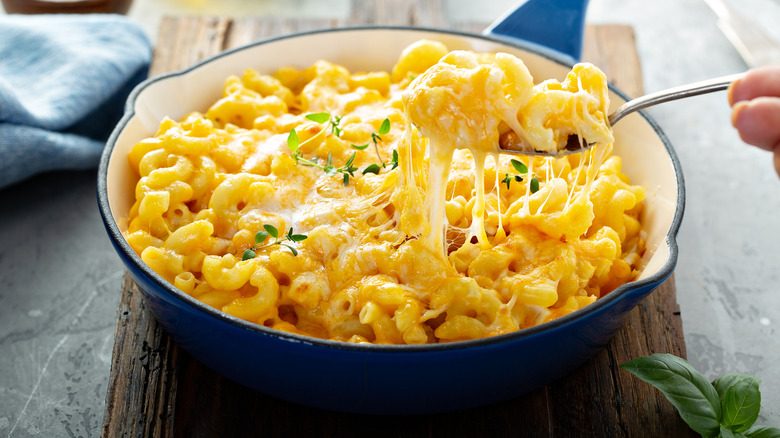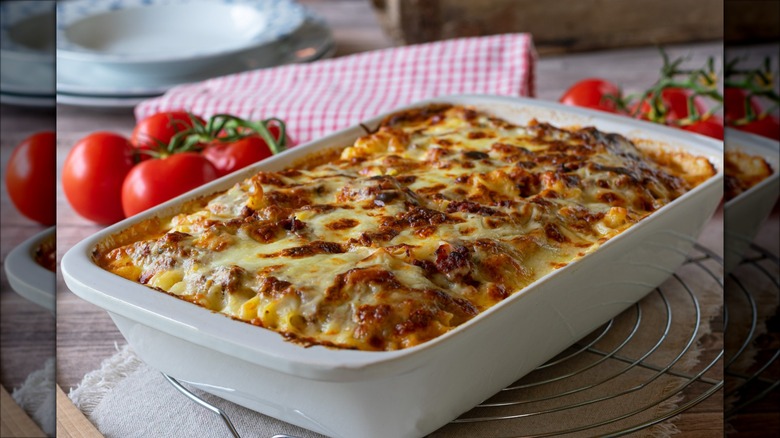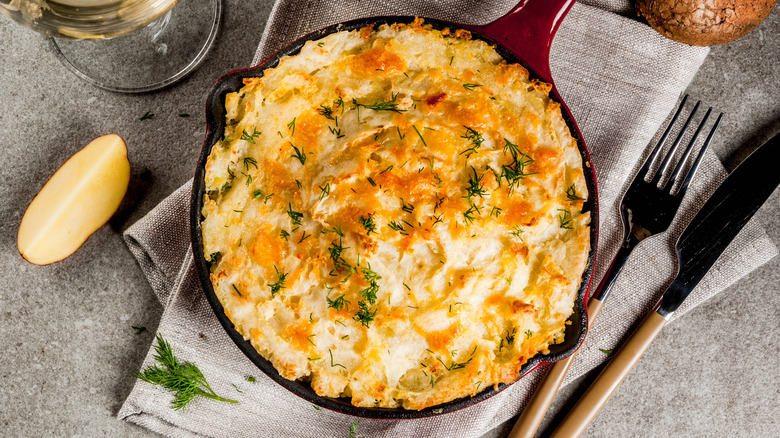The Ancient Etymology Behind The Word 'Casserole'
We may receive a commission on purchases made from links.
If you're unfamiliar with and/or a little wary of casseroles, goopy green beans and tuna fish might be the first things to come to mind at the very mention of the word. However, a cookbook dedicated to casseroles might comprise of a whole class of dishes you didn't even realize fit the bill, like lasagna and deep-dish pizza. According to Masterclass, the word in its simplest terms means "a one-pot meal that involves combining the ingredients in an oven-safe dish and baking them." The platform also notes that a cast-iron skillet "could technically serve as a casserole dish," since it's often used as a vessel for baked dishes.
Winter is coming, which means it's high time for deeply comforting breakfasts, dinners, and everything in between — ones that only require a single casserole dish to deliver gloriously layered, vigorously bubbling, and sometimes cheesy one-pan meals in the oven. And as you might guess from the medieval origins of moussaka, itself a type of casserole, the word "casserole" itself long predates the days of Pyrex.
From ancient Greece to 18th-century England
According to Masterclass, the germination of the word "casserole" may have taken place in ancient Greece. The platform explains that the Greek word kuathion, which translates to "little cup," gave way to the medieval Latin word cattia; in turn, this yielded to the French cassole, or "stew pan," and eventually to the English "casserole." If you were cooking rice and meat in a baking dish in the eighteenth century, you would have introduced it to your dinner guests as a casserole.
The Online Etymology Dictionary summarizes that the word "casserole" became official in 1706, but was used solely to describe the cooking vessel. It wasn't until 1889 that the word was also used to describe dishes cooked in casserole vessels. Of course, the French word cassole (or cassoulet, if you please) is still used to describe a particular kind of casserole dish — one that's made in a special glazed earthenware pot, and that some consider the national dish of France.
A slow cooker without the crock pot
If you're the kind of person who likes to use terms like "Maillard reaction" when you're cooking, you're in good company. You also might be interested to know the science behind casserole pans and other deep, heavy-bottomed dishes. The Cookware Advisor touts casserole dishes as "part of the fabric of kitchen life," noting that they're ideal for retaining heat come serving time. The Los Angeles Times adds that heavy-bottomed pots and pans are "thicker at the base," allowing them to slowly and evenly distribute heat on the stove and in the oven. "Thin pots and pans are more prone to 'hot spots' — areas that heat more quickly than others," says the outlet.
Casserole and heavy-bottomed dishes come in all sorts of different materials, from glass to clay to cast iron, and they all serve different purposes. The Cookware Advisor says glass dishes are best for acidic foods, as they "draw a metallic taste out of the dish." Cast iron, on the other hand, has a cult following of its own. The material gets its cooking magic from the duel process of polymerization and carbonization, which involves "seasoning" the pan with a thin layer of polymerized oil (such as canola or grapeseed oil). Once baked in, polymerized oil "cannot be easily removed," per the Science of Cooking. The result is a naturally non-stick pan that, like a casserole dish, conducts heat evenly and guards against burning.


